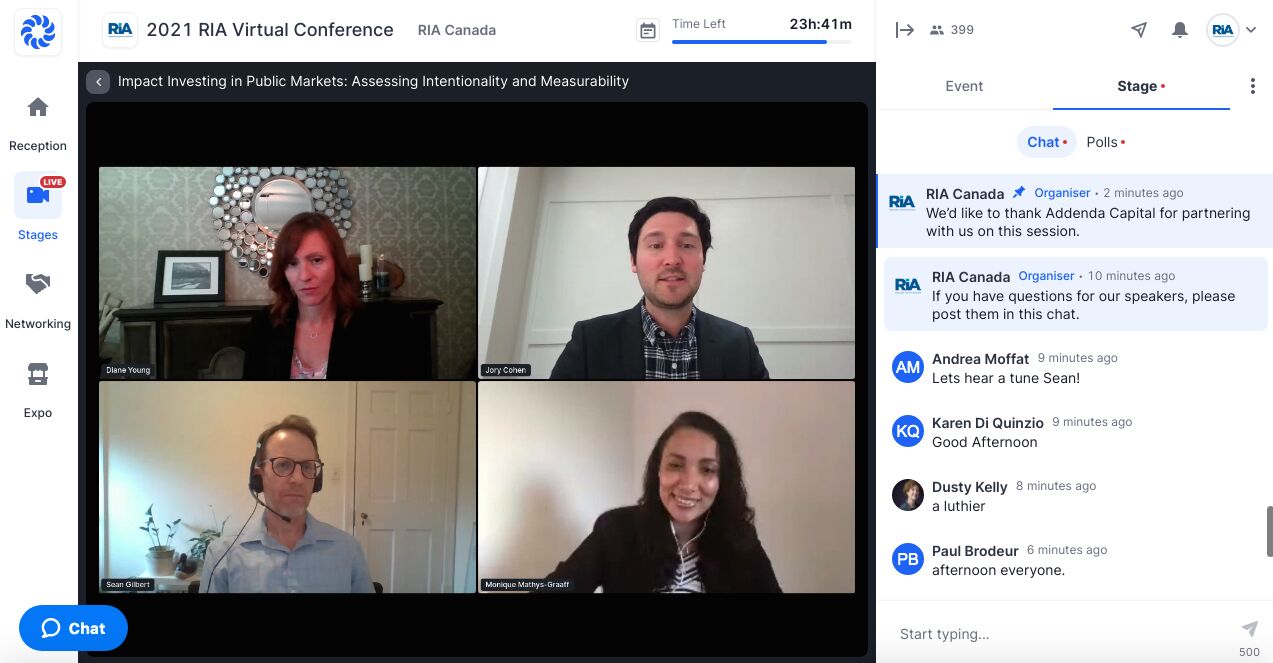
Speakers:
Monique Mathys-Graaff, Senior Advisor and Public Markets Lead, Impact Management Project
Sean Gilbert, Director, Member Engagement, Global Impact Investing Network
Jory Cohen, Director of Finance and Impact Investment, Inspirit Foundation
Diane Young, Senior Portfolio Manager, Fixed Income & Co-Head, Corporate Bonds, Addenda Capital
Over the years, there’s been a turning point in understanding the term fiduciary duty in the institutional and pension fund space, said Diane Young, Senior Portfolio Manager, Fixed Income and Co-Head of Corporate Bonds at Addenda Capital at the Responsible Investment Conference on Thursday.
“Plans are now not just looking at the returns on their assets, but the underlying assets themselves. There is this idea of sacrificing returns that pension plans were wary about [when it came to impact investing], but I think that’s been largely dispelled with the most recent philosophy.” she said.
“Pension plans are looking more broadly at what their duty is to their beneficiaries.”
Young, along with moderator Jory Cohen, Director of Finance and Impact Investment at Inspirit Foundation, and fellow panelists Sean Gilbert, Director of Member Engagement at Global Impact Investing Network, and Monique Mathys-Graaff, Senior Advisor and Public Markets Lead at the Impact Management Project, discussed the evolve nature of impact investing in public markets.
“From a regulation perspective, we’ve been seeing policy standard sectors mainstreaming,” Mathys-Graaff added.
“Particularly, I think you could look at the IFRS [The International Financial Reporting Standards] foundation’s announcement of the Sustainability Standards Board. It speaks to more deliberate consistency in the data that we can expect to see that will only benefit the great momentum we have in ensuring that impact management practices and performance can scale for public markets.”
Gilbert added that the industry is trying now to focus more on intentionality and measurement, and noted three key changes when it comes to impact funds:
1. Articulation of impact objectives
Companies are doing a better job of specifying the sort of change they want to see in the world. For instance, funds are articulating purpose, such as “to invest in the companies that are developing solutions specifically for X, Y and Z,” Gilbert said. “That would play over into the types of specific companies that would go into their portfolio.”
2. The types of data being used
Funds are trying to take information about a company’s outputs and translate into what it means for a particular objective. “And, more importantly,” Gilbert said, “for the stakeholders that make the world around the company. What does it mean for places, things, people, and particular changes that the fund felt was important in the real world?” he asked.
3. The nature of engagements
“Shareholder engagement has been around for 40 to 50 years and has contributed a lot in terms of making a difference,” Gilbert said. “For some impact funds, we can see that the types of topics they choose to focus on are much more closely tied to the impact thesis that they put into the strategy of their fund.”
Looking to the future
To close the session, Cohen asked the panelists what impact investing in the public market will look like five years from now.
“Trends over the last few years make it very clear that investors want financial returns but they also want financial returns done in a way that delivers returns to the real economy and the places they live in,” Gilbert said.
“I think the challenge for the industry is if people want multiple kinds of returns, like financial returns and returns for the real economy. How do we deliver the products that do that with authenticity? It will have to involve innovating how we go about our investment processes because simply repacking the products that we’ve been offering and the investment processes we’ve been offering for the last 15 or 20 years in response to the kind of demand that’s emerging will probably fall short of expectation.”
Young noted that there will be an “explosion of supply of at least fixed income opportunities.”
